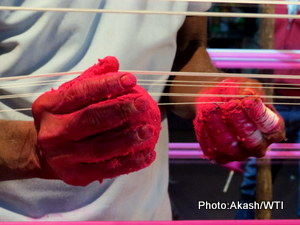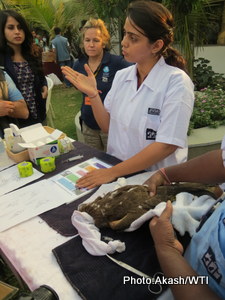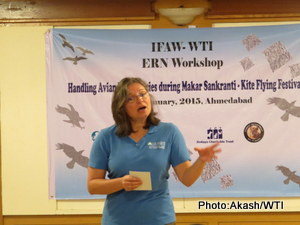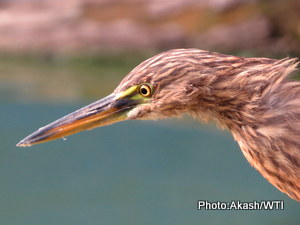Birds calling: What do they really say?
In this blog, Dr Piyush Shastri talks about his experience in handling avian emergencies during the Makar Sankranti festival and how the recent ERN workshop laid a roadmap for future in handling avian emergencies across the country.
Delhi, February 17, 2015: It all began seven years ago, when for the first time, I heard about injured birds and the kite flying festival of Makar Sankranti. At the first instance, I failed to comprehend the magnitude of damage caused to the avian community by something as harmless as paper kites and cotton threads! Curious to know more, I attended the two-day camp organized by a very small organization, Raksha, which worked to save the birds in Jaipur. I was appalled at sheer number of injury cases coming in at the makeshift hospital in the heart of the city! There were severed wings, lacerated muscles, fractured bones and bloodshed everywhere. Reason: The thread used to fly kites (manjha) is coated with a mixture of glue and powdered glass to give it that cutting edge to compete with other kites in the sky. When in flight, these birds don’t notice these very fine threads and come in contact with them resulting in fatal injuries.
Never in my wildest dreams had I ever thought that a simple act of celebrating a kite flying festival could result in mass massacre of innumerable birds across the country. Ever since then, I have been working with Raksha for the cause of saving birds injured during the Makar Sankranti festival. Further learning also revealed that kite flying is disastrous not just for our feathered friends, but for humans alike. Several instances of humans being killed and injured by the manjha have been reported from different parts of the country. As years passed, my limited knowledge as a budding veterinarian grew from applying a cotton ball soaked in iodine solution on the wound to learning the technique of sewing up the lacerated ends of the wings and the use of anaesthesia.
While working with Raksha, it became clear that merely saving injured birds was leading us nowhere. Awareness became the need of the hour to bring down the number of injuries to birds to really make a difference. We at Raksha then started to aggressively pursue awareness campaigns in schools, colleges and public places to educate people about the bloodshed caused by the glass coated manjha. It showed results with thousands of school kids and general public pledging not to use manjha and not flying kites at specific times of the day when birds are known to be most active in the sky.
It took seven years for me and my group to understand the issue well and to device means to prevent injuries. Yet, there was a feeling that we hadn’t even covered the tip of the mighty ice berg! The number of avian casualties in Jaipur is a fraction of what has been recorded in cities like Ahmedabad, Baroda, Surat, among several others. A more comprehensive approach was required to be adopted in order to deal with the issue. On a pan-India level there were hundreds of organizations involved in bird rescue and doing things their own way. Nonetheless, the number of injured birds rescued by all these groups only showed an upward trend year after year.
handle injured birds.
When I was assigned to zero down on a subject to be addressed for this year’s Emergency Relief Network (ERN) workshop, I was clear that the focus of the workshop had to be on avian emergencies during the kite flying festival. The gap analysis pointed out that many organizations in spite of being actively involved in this field since a long time, felt better rescue techniques were required when dealing with wild birds. They needed experienced avain veterinarians, better crowd and volunteer management skills, post operative care and management of birds undergoing rehabilitation.
In Ahmedabad, where we held the workshop in association with Jivdaya Charitable Trust (JCT), kite flying is one of the most adored sports. The skies are crowded with colourful kites which are flown by people of all age groups. The number of kites competing for space with birds is staggering. Ahmedabad is believed to be the hub of “kite fighting” with enthusiasts pouring in from far off places to participate in the competition. Each year a team of vets, rescuers and volunteers at JCT attend to thousands of birds in a span of one week around the festival. The avian section of JCT was a suitable place for imparting practical training to the participants on various aspects of rescue and rehab of injured birds.
Similar workshops and training sessions conducted in the past by governmental and non-governmental agencies were either too scientific or based purely on experiences gained by the trainers over a period of years. There have been very few instances that a combination of scientific knowledge, field experience and need for awareness were woven together in a single training module.
There has always been a rush of enthusiasts wanting to come and help these unfortunate birds who become victims of this traditional festivity. However, none of the enthusiasts were willing to question the traditions and culture. Therefore, this workshop was designed to be different from the participants’ expectations. It had an underlying current urging all the participating organizations and volunteers to carry out mass awareness drives to prevent kite string injuries rather than the conventional outreach: “What to do if you see an injured bird?” The thought was well taken by all the participants who agreed to focus more on preventive awareness rather than lone curative awareness. The working groups of rescue and first aid, veterinary intervention and post surgical care, rehabilitation and awareness were formed to come up with best practices for different components relating to avian emergencies during the kite flying festival.
At the end of the workshop, it was good to have participants come and praise the efforts put in by IFAW-WTI team in organising this unique workshop which according to them laid a roadmap for future in handling avian emergencies. The participants pointed that the workshop encompassed several facets that were either ignored or were rarely discussed in similar workshops held earlier.
Yet, there was a lot left desired. My previous experiences in handling avian emergencies in Jaipur kept reminding me how difficult it is to convince humans to give up their passion of kite flying which has become the single largest threat to birds in these areas.
In Jaipur, our makeshift camp was adjacent to a prominent pigeon feeding spot where people in thousands would come to feed the birds in their luxury cars on the auspicious day of Makar Sankranti (14th January). A few of them would come over to the camp out of curiosity or upon insistence of their kids and learn about the plight of birds during this festival. Invariably, each one of them would reach for their pocket and drop some money into the donation box with bandaged fingers (the glass coated thread also causes cuts on the fingers of people flying kites) and then get back into their cars which would have stacks of kites in their backseats. This scene repeated every time, year after year. I was amazed by the manner in which guilt acts upon human minds. The plight of the birds did not make the person give up his passion of kite flying, but he did think about helping these birds and tried washing off his sins by donating some money.
We humans are known to take the route which appears easier for us to tread. Preventing injuries to birds seems to be a tough job for it involves fighting with your own wishes and desires! Also, an awareness campaign asks for a lot of co-ordinated efforts, but lacks the thrill of being physically involved in helping birds.
However, bird saviours do need to realise that to save the birds, masses have to be made aware and moved enough to give up their passion for “kite fighting” which is so deeply entrenched in their culture and tradition. That indeed is a much steeper task as compared to just saving maimed birds.














